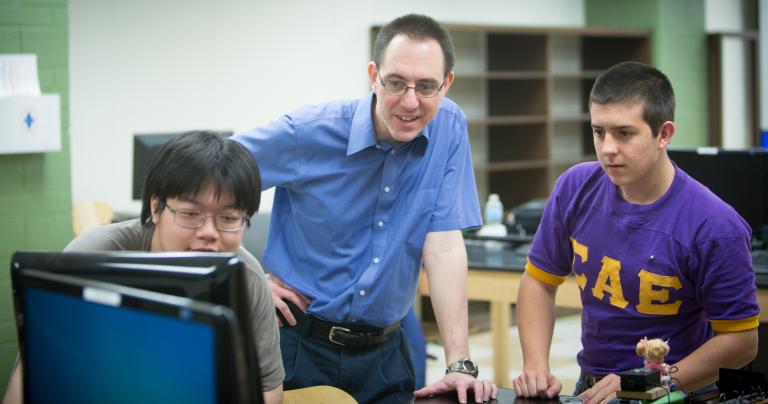
Dr. Ronald Kumon, Physics faculty member at Kettering University, along with collaborators from multiple disciplines across campus, has been awarded a National Science Foundation - Major Research Instrumentation (NSF-MRI) grant for $251,274.
Kettering University faculty have received 12 NSF-MRI awards since 2012—more than any university in Michigan during that time.
The NSF-MRI grant allows Kettering University to purchase an advanced fluorescence microscopy system, which will allow faculty and students to take high-resolution, three-dimensional imaging of cells on a microscopic scale. These capabilities allow molecules and nanoparticles that have potential for enhancing disease treatments to be tracked relative to various parts of the cell. Among other research, faculty members will conduct interdisciplinary research broadly themed around physical, chemical and biological methods cellular processes with the goal of improving treatment of cancer and other diseases.

“We want to understand how we can use nanoparticles to treat cancer and other diseases,” Kumon said. “Nanoparticles are promising. They are small and can get into cells. We have to understand how the interaction happens, how they are taken into cells, how they could be used to heat up cells. If you want to use them for treatment, you have to know how they work.”
Co-principal investigators include Dr. Lihua Wang, Chemistry and Biochemistry; Dr. Gillian Ryan, Physics; Dr. Corneliu Rablau, Physics; and Uma B. Ramabadran, Physics.
Projects planned for the microscope include:
-
Studying the mechanisms of ultrasound-mediated delivery of fluorescent agents to cells in the presence of microbubbles to potentially enable better non-invasive spatiotemporal control of drug delivery.
-
Studying the symmetry-breaking mechanisms of eukaryotic cells during movement with fluorescent dyes to contribute to an improved understanding of metastasis.
-
Studying the uptake and distribution of fluorescent magnetic nanoparticles in cancerous cells and spheroids with magnetic and ultrasonic methods. The magnetic nanoparticles can potentially be used for noninvasive hyperthermic cancer treatment via induction heating.
-
Studying the biotoxicity of fluorescent silver nanoparticles on yeast as a model for treating infectious fungi.
-
Testing the fluorescent gold nanoclusters as a means to image beta-amyloid aggregates and study the process of beta-amyloid plaque formation toward a better understanding of Alzheimer’s disease.
-
Developing fluorescent quantum dots and characterize their ability to act as nanothermometers in the intra- and extracellular environment during hyperthermia.
The purchase includes an inverted microscope with epifluorescence components and light source, an electron-multiplier charge-coupled device camera and a confocal laser scanning system, all of which are critical for the study of the localization and transport of molecules and nanoparticles in the proposed work. The microscope’s illumination is provided by focused lasers so it’s bright, Kumon said, and researchers can use dyes to highlight different features of the cells.
“This particular microscope can take images of thin sections. As a result, you can stack those images and create 3D pictures of cells,” Kumon said. “It’s useful, for example, if you’re looking at how to deliver drugs or genes into the cells, and you’d like to see how the cells temporarily open up when treated various ways.”
Kumon also wants to invite students in the Genesee Intermediate School District and other Michigan schools to interact with the system and possibly even have remote viewing opportunities for learning about the microscope, which is above what high school and undergraduates typically see in the classroom.
“We’re hoping to provide another mechanism for students to interact with microscope and get access to more advanced technology,” he said.